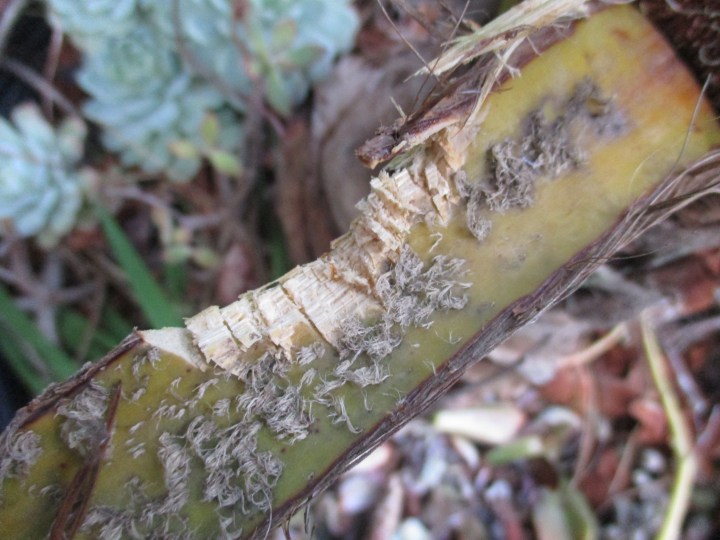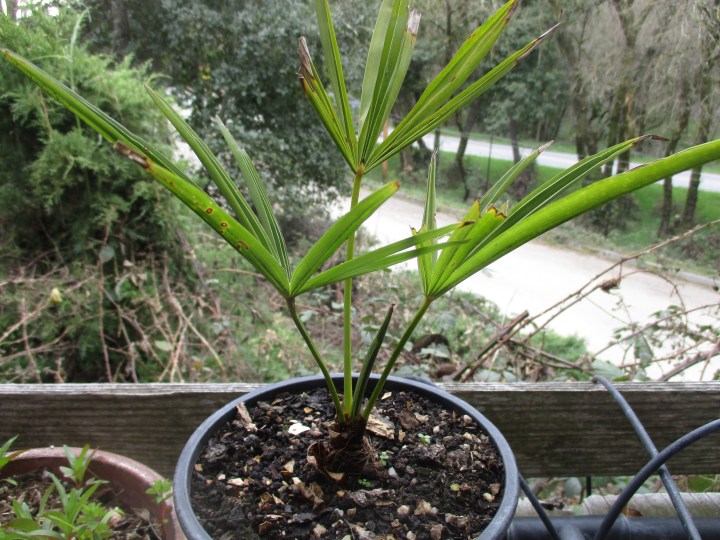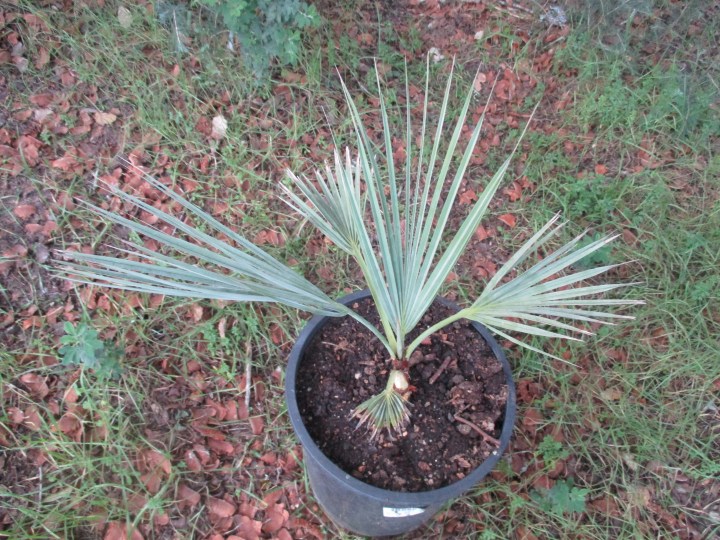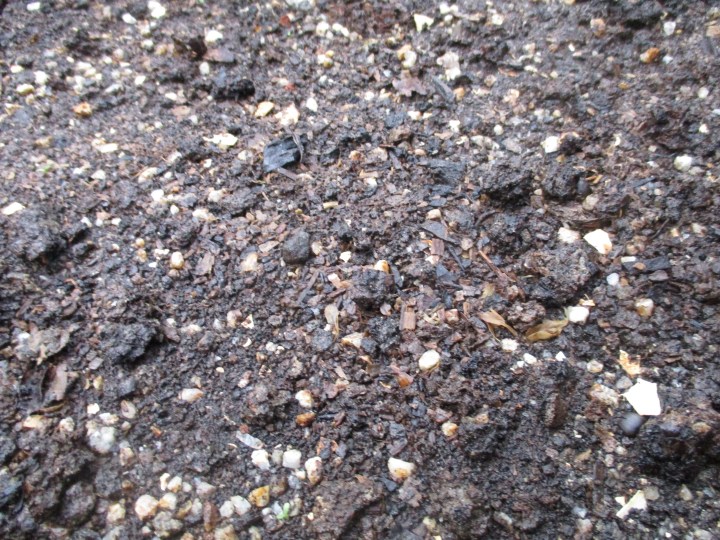That is how horticulturists say, “Talk to the hand.” During the past three and a half decades that I have been working with landscape designer, Brent Green, I have deduced that there is not a specimen of Washingtonia filifera in the Santa Clara Valley, or anywhere else for that mater, who is any more interested by what I have to say than he is. Nonetheless, I appreciate palms.
1. Rats! I thought that was who chewed on a petiole of my favorite young windmill palm from Western San Jose. However, this picture shows several small slices made with a straight blade!
2. Pleats of an aging fronds of the same windmill palm demonstrate that surfaces exposed to the south deteriorate before those exposed to the north. The frond was tilted up for this picture.
3. Windmill palm seedling is one of a few that I pulled from a landscape nearby, but could not bear to discard without at least trying to find a home for them; as if we need another palm here.
4. Hesper palm is more interesting. I brought two here while they were nearly dead. The other did not survive. This one tried to recover, died back again, and is now trying to recover again.
5. McCurtain scrub palm seed that I was so pleased to procure earlier is what is obscured just below the surface in this flat. I am concerned that the compost might not have been ready.
6. Seed of other odd species of palm were found in a package that had been in storage for a few years. As if we need another palm here, all will get sown. Sadly, few are likely to still be viable.
This is the link for Six on Saturday, for anyone else who would like to participate:
https://thepropagatorblog.wordpress.com/2017/09/18/six-on-saturday-a-participant-guide/
Palms everywhere! Nice to see. Good luck with the germination.
LikeLiked by 1 person
Thank you. I am so concerned about what the seed are in now. It does not seem to be completely composted. Not only would I feel horrible if it is bad for the seed, but I would be too embarrassed to ask the suppler to send me more after not taking care of the first batch. . . . and after losing all those other rare seed for so long!
LikeLiked by 1 person
In the wild they wouldn’t have a perfectly composted seed medium, but I can understand your worry. I’m sure you will have some successes.
LikeLiked by 1 person
Actually, in the wild, some of those farther south live in swampy conditions that are clogged with copious uncomposted foliar debris, and they obviously have no problem with it. I SO hope that mine don’t either.
LikeLiked by 1 person
As I said I love palms ! 😀 good luck with the germination
LikeLiked by 1 person
Thank you. It will be a tense few weeks as I wait for them to germinate. I really should have procured some better germination medium, or even purchased some simple potting soil.
LikeLiked by 1 person
No palms here. Hope yours flourish
LikeLiked by 1 person
There could be. The McCurtain scrub palm, although still rare, is becoming more popular with those in climates in which winter is too cold for other palms. The windmill palm, which is one of the five most common palms here, does quite well in the Pacific Northwest and Oklahoma.
LikeLiked by 1 person
I shall look up Mccurtain
LikeLiked by 1 person
McCurtain scrub palm is more of a foliar plant that does not develop a trunk. I happen to like it because it is the only palm that is native to Oklahoma. I suppose it is nice for those who want to grow it in a pot where there are not many other palms to choose from, or where these is no space for a palm tree. However, I would not recommend it for someone who would like a palm ‘tree’.
LikeLike
The windmill Palm I am familiar with.
LikeLiked by 1 person
Windmill palm is just as resilient as McCurtain scrub palm, and is more like what people expect a palm to be like, although smaller.
LikeLiked by 1 person
I envy you your palms. I love them. We have a ‘cabbage palm’ which is a bit of an archetype in theUK south west peninsula. But this year I plan to put in a couple more that I hope will stand up to our wet and windy climate – probably a trachycarpus as they seem to do quite well here. I’d really like to try the more imposing brahea but I’m not sure I’ve really got space.
LikeLiked by 1 person
Cabbage palm is actually related to the McCurtain scrub palm. They certainly do not look related, since the McCurtain scrub palm lacks a trunk. The common windmill palm is one of the most popular palms in the Santa Clara Valley, and is small enough to fit into urban gardens. It also happens to be one of the most resilient. As I mentioned in other comments, it is quite happy in the Pacific Northwest and Oklahoma. Since you are in a windy climate, you might want to investigate varieties of windmill palm or other species of Trachicarpus with stiffer foliage that does not get battered as much by cool wind. To me, the foliage of windmill palm ‘should’ be soft and a bit floppy at the tips from the wind. Those in San Francisco and Seattle look just fine and normal too me. However, some palm enthusiasts believe that those that are more resilient to wind are prettier in cool and windy climates. The other species and varieties are significantly more expensive, but would be worth the expense if that is what you prefer. (If I could, I would recommend the common windmill palm.) I would not recommend the hesper palm though. They prefer warm and dry climates. The most exemplary specimen that I know of are in dry landscapes in San Jose, although they can tolerate average irrigation if the weather is warm through summer. Those on the coast, where summers are cooler, are not happy at all.
LikeLike
Would you like me to send small seedlings of Trachycarpus fortunei? There are only three out there, but I could grub up two more if necessary. By the time I strip the outer leaves off, and remove the soil from the roots, they would not look like much more than a few blades of coarse grass, but they grow like weeds. You can send me a message at lghorticulture@aol.com with your mailing address, and then post a comment here so that I know to look for it.
LikeLike
Thanks, Tony, but I think sending/bringing seedlings into the UK from overseas may be illegal…..
LikeLiked by 1 person
Oh, of course.
LikeLike
Your title made me smile but I could not make out the sentence about the Washingtonia, which might have been part of the same joke. How has the young palm been cut, do you think?
LikeLiked by 1 person
When I talk to a palm as Brent suggests, even the palm is uninterested.
I think someone was sharpening their pocket knife over there, and tried it out on the petiole.
LikeLike
I had Windmill Palms in Atlanta, although I don’t know if they are still alive. I have one very odd looking Bismarck Palm from seed – the shoot is curly? any idea why? Good luck with your seeds I found some Sweetshrub seeds today I had been looking for about a year. We’ll see how those do..good luck. Have you seen toptropicals in SW Florida, they sell some crazy seed.
LikeLiked by 1 person
In the Santa Clara Valley, curled leaves among seedlings are likely to be caused by nutrient deficiencies. The soil is excellent, but somehow slightly deficient in micronutrients that palms crave. Queen palms are particularly sensitive, and even mostly healthy trees can exhibit symptoms associated with magnesium or manganese deficiency. After saying all that, I do not know what, if anything, would be lacking in the soil there. In your region, fungal pathogens that do not concern us in our arid climate may deform developing leaves, particularly while sheltered. I really do not know the problems that palms experience in your region.
Toptropicals is one that I am not yet familiar with. For now, I will be prioritizing what is already here rather than procuring more. An article about all the palm and other seed that I just ‘found’ recently will be posted.
LikeLike